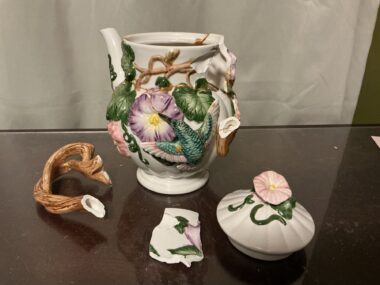How I’m using kintsugi to repair a coffeepot and heal with CAD
A columnist learns to celebrate flaws, rather than hide them

I was heartbroken when I unpacked my luggage a couple weeks ago and found my beautiful coffeepot smashed into 22 pieces with accompanying shards and small chips. In my tiredness, a moment of good decision-making pressed through: I didn’t throw it away, as is my current habit. I knew I needed to find some time to appreciate the memories and beauty of the coffeepot before banishing it to the rubbish heap.
When I wrote “Travel leaves CAD patient feeling like a broken piece of crockery” two weeks ago, a kind reader suggested I try to repair it with kintsugi. Kintsugi is the art of ceramic repair using a lacquer or epoxy dusted with a gold or silver powder. It doesn’t try to hide the damage, but instead highlights it as a celebration of the use, worth, and value of the object.
“How profound!” I thought. “This is exactly right.” I set about immediately acquiring both the information and the materials needed. The thought also came to me that we “CADdies” — those of us with cold agglutinin disease (CAD) — can benefit from this mindset as well.
Brokenness of CAD
In contrast to the suddenness of crockery being smashed, my CAD did not suddenly happen. The symptoms developed gradually, over at least 15 years. In 2018, doctors finally recognized my illness as CAD and implemented a treatment plan. I feel the same now as I piece the coffeepot back together. Following the kintsugi suggestion, my spirit started moving from a dark place back into the light. A righting of wrongs had begun.
After my CAD diagnosis, doctors were able to address my fatigue, pallor, acrocyanosis, and other symptoms. I studied the mechanics of CAD — how the red blood cells (RBCs) would clump together and the white blood cells would designate those clumps as foreign bodies. Inside my blood vessels a war was waged, and the destruction of my RBCs ensued. I learned my best defense against such a war was staying warm.
With my coffeepot, I cleared a spot on a table in my hobby room. I carefully unpacked the pot and assessed the damage. I gently fitted one piece of crockery with another and decided where I would start my gluing. I reviewed the equipment — the epoxy, gold dust, and assorted application tools — then read and reread the process of kintsugi before beginning.
The repair is now proceeding, slowly and deliberately. I am constantly assessing the progress and adjusting as I go along.
It has been seven years since I was diagnosed with CAD. At that time, I received four weeks of Rituxan (rituximab). Then, in late 2020, I received another set of infusions, followed in 2021 by treatment with rituximab and bendamustine. The repair of my body is proceeding, slowly and deliberately. I, along with my medical team, am constantly assessing the progress and adjusting.
Not just healing, but shining

Amazingly, the lid came through the journey unscathed. I have one more piece to fit, followed by applying the handle-stem. I’ll then clean up the pot and embellish the cracks with another layer of gold. The goal is to accentuate and beautify the repair, rather than try to hide it. (Photo by Mary Lott)
The lesson I’m learning as I put into practice the art of kintsugi is to not hide the flaws. They illustrate the ability to come together, to become whole and useful again. The cracks and blemishes show that I’ve enjoyed the coffeepot in the past and that it has been valued over time. It is part of my journey through life.
CAD is a similar flaw. Although I must adjust my lifestyle because of it, my response to those adjustments — staying warm, getting rest as I need to, pacing my activities — is like the sprinkling of gold dust on the surface of my coffeepot repair. It makes me personally more attractive.
My coffeepot is almost complete. It will never be the same again, though. It’s made more beautiful by its scars and will be a continual reminder of how much I’ve enjoyed it over the years.
I am grateful to the gentleman who suggested I try kintsugi. I’m reminded that I carry flaws and scars because I have a history. They show me I am resilient, even in the face of a persistent autoimmune disease. These scars and how they have shaped my beautiful personality are part of my history. This I can celebrate.
Note: Cold Agglutinin Disease News is strictly a news and information website about the disease. It does not provide medical advice, diagnosis, or treatment. This content is not intended to be a substitute for professional medical advice, diagnosis, or treatment. Always seek the advice of your physician or other qualified health provider with any questions you may have regarding a medical condition. Never disregard professional medical advice or delay in seeking it because of something you have read on this website. The opinions expressed in this column are not those of Cold Agglutinin Disease News or its parent company, Bionews, and are intended to spark discussion about issues pertaining to cold agglutinin disease.







Jan Stanley
Thank you so much for these stories! I always look forward to them! They have helped me understand how to live and deal with CAD and not feel sorry for myself or scared. Thank you!
Mary Lott
You are very kind. I am so glad you are encouraged by them.
Helen Bohl
I have all the same symptoms and have been diagnosed with WM and been recommended to take Brutinab do you have any suggestions
Mary Lott
I'm sorry. I don't have any clue. My initial diagnosis in 2018 was for a slightly different type of cancer. The WM is entirely new to me. I will be undergoing a bone marrow biopsy and then will be hearing my doctor's recommendation then. Hopefully, we can compare notes then and learn from each other.